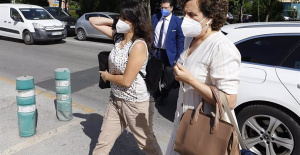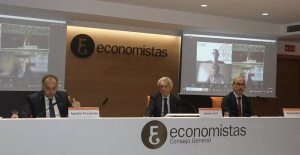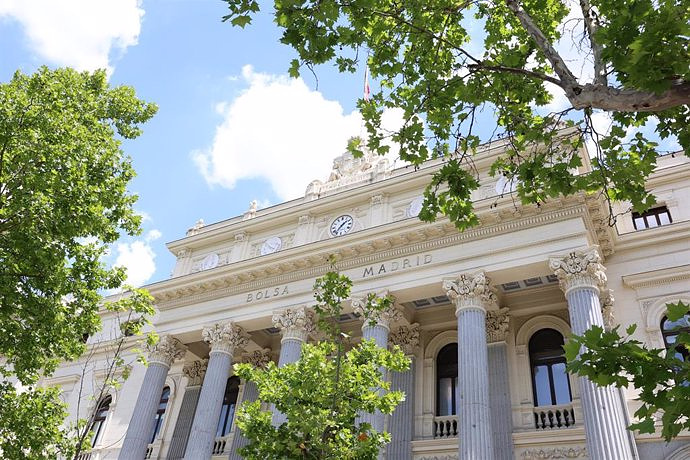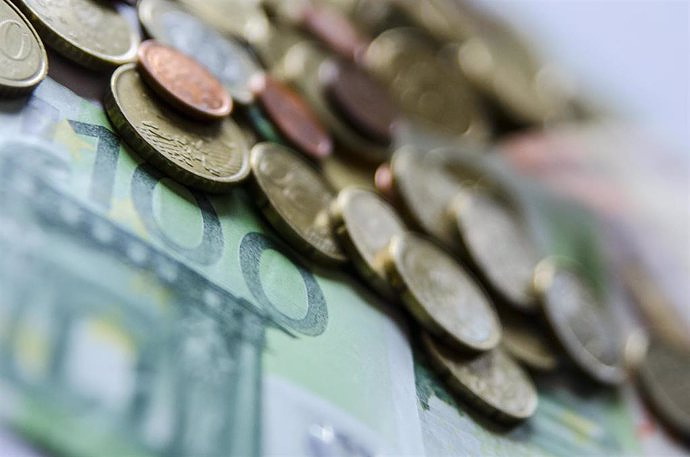MADRID, 30 Sep. (EUROPA PRESS) -
The Bank of Spain has decided to maintain the countercyclical capital buffer (CCA) applicable to the credit exposures of banking entities in Spain at 0% for the fourth quarter of 2022, after having analyzed the macrofinancial environment and the evolution of credit, as well as such as the situation in the real estate market, but has asked the entities to "exercise their prudence" in the allocation of provisions and in capital planning.
The countercyclical capital buffer is a macroprudential instrument designed to reinforce the solvency of the banking system by accumulating capital in phases of economic boom, which is when the accumulation of systemic risks usually occurs, in order to be used later when risks materialize. that may affect financial stability.
To make its decisions, the Bank of Spain regularly monitors the evolution of the financial cycle by analyzing the evolution of various indicators, the 'credit-GDP gap' being one of the most relevant. This indicator measures, for a given date, the deviation of the ratio of total credit to the non-financial private sector over GDP with respect to its trend level, so that a positive and growing value of the gap would be associated with upward risks linked to the growth in the volume of credit.
The 'credit-GDP gap' increased significantly at the beginning of the coronavirus pandemic, as a consequence of the abrupt fall experienced by GDP and the growth of credit due to public support measures, for which the Bank of Spain considered that the rebound it could not be interpreted as a systemic warning signal. The "temporary" nature of this rebound is reflected in the progressive correction that the indicator has shown in recent quarters, driven by the recovery in economic activity since mid-2021.
For the coming quarters, the supervisor indicates that the strong uncertainty generated by the war in Ukraine, inflationary tensions and the tightening of monetary policy could affect the economic recovery process and, consequently, the rate of future correction of the 'gap credit-GDP'.
The Bank of Spain analyzes other complementary macrofinancial indicators that, as a whole, "an endogenous accumulation of systemic risks". It affirms that the evolution of GDP shows a still incomplete recovery of the pre-pandemic level of activity, while the increase in macroeconomic risks linked to inflationary pressures and geopolitical tension may slow down this recovery process.
At this point, it indicates that the possible aggravation of the negative supply conditions, especially the increase in the cost or reduction in the availability of energy supplies, is a "risk factor" for economic activity of "particular relevance", and that it would support the convenience to maintain the CCA percentage at 0% in order to avoid potential pro-cyclical effects.
In this regard, the Bank of Spain deepens that, in an environment of materialization of the risks indicated to the downside on economic activity, the moderation of credit that would entail a possible activation of the CCA would not only not contribute to reducing the level of systemic risk, but also which would further weaken GDP.
However, it states that entities "must exercise extreme caution" both in their provisioning policy, which must take into account the greater probability of these downside risks materializing on activity, and in their capital planning, a element that the Bank of Spain points out as "key" so that entities can continue to carry out their task of providing financing to households and companies with viable projects without tension.
Other indicators used by the supervisor, such as credit intensity (ratio of the flow of new credit to GDP) and the debt service ratio (ratio of debt principal and interest payments to GDP), are found at moderate levels and the Spanish economy maintains a surplus in the current account balance.
In any case, the Bank of Spain will maintain a "close monitoring" of these metrics. In particular, it forecasts that the increase in interest rates in the financial markets will cause the debt service ratio to begin to increase in the coming quarters.
The Bank of Spain has continued to monitor "closely" the situation of the real estate market, since its evolution is "very relevant" in the decisions of the CCA. The data handled by the supervisor shows that house prices maintained a high growth rate during the second quarter of 2022, with an annual variation of 8%, although slightly lower than the 8.5% of the previous quarter.
In this sense, the supervisor affirms that the indicators on imbalances in the prices of this market continue to show "some signs of overvaluation", although they continue to be contained below those of other European countries that have already activated some macroprudential tools.
Regarding real estate transactions, home sales continued to grow strongly in the second quarter of 2022, mainly due to used home sales. However, the data for July, which registered a year-on-year growth in home sales transactions of 8%, suggests a slowdown that the Bank of Spain hopes to confirm with the arrival of new information.
Also, consistent with the expansion of transactions, new mortgage transactions continued to experience significant dynamism in the first half of the year. The flow of new credit for home purchase increased by 10.9% in the second quarter of 2022 compared to the same quarter of 2021. However, given the high volume of repayments and the relatively low weight of new credit over the total volume due Due to the long duration of the loans, the Bank of Spain indicates that the balance of mortgage credit continues to grow in a stable and moderate way, at a rate of 1.3% year-on-year in June 2022.
In parallel, credit for construction and development activities continued to contract, with a year-on-year drop of 6.7% in June 2022, in line with the lower dynamism of the new housing market.
The Bank of Spain also highlights that the standards for granting credit for new residential mortgages have not experienced significant variations during 2022, while interest rates continued at low levels at the end of the second quarter of 2022. In this sense, the supervisor explains that the spreads of these rates with respect to the reference rates continued to narrow, which could imply that the pass-through of the increases observed throughout 2022 in the reference interest rates would be slower than in previous historical periods of increases of types.

 Exploring Cardano: Inner Workings and Advantages of this Cryptocurrency
Exploring Cardano: Inner Workings and Advantages of this Cryptocurrency Seville.- Economy.- Innova.- STSA inaugurates its new painting and sealing hangar in San Pablo, for 18 million
Seville.- Economy.- Innova.- STSA inaugurates its new painting and sealing hangar in San Pablo, for 18 million Innova.- More than 300 volunteers join the Andalucía Compromiso Digital network in one month to facilitate access to ICT
Innova.- More than 300 volunteers join the Andalucía Compromiso Digital network in one month to facilitate access to ICT Innova.-AMP.- Ayesa acquires 51% of Sadiel, which will create new technological engineering products and expand markets
Innova.-AMP.- Ayesa acquires 51% of Sadiel, which will create new technological engineering products and expand markets Juana Rivas's legal team manages to repeat the trial "that separated the brothers" in Italy
Juana Rivas's legal team manages to repeat the trial "that separated the brothers" in Italy The New York Justice annuls Harvey Weinstein's conviction for sexual crimes and orders a new trial
The New York Justice annuls Harvey Weinstein's conviction for sexual crimes and orders a new trial Socialist militants promote a large demonstration in support of Sánchez on Saturday in Ferraz
Socialist militants promote a large demonstration in support of Sánchez on Saturday in Ferraz Families with average income allocate a third of their income to paying taxes, according to economists
Families with average income allocate a third of their income to paying taxes, according to economists How Blockchain in being used to shape the future
How Blockchain in being used to shape the future Not just BTC and ETH: Here Are Some More Interesting Coins Worth Focusing on
Not just BTC and ETH: Here Are Some More Interesting Coins Worth Focusing on Retrópolis brings the golden age of video games and computing to the UPV
Retrópolis brings the golden age of video games and computing to the UPV Looking for video games that value the neighborhoods of Valencia
Looking for video games that value the neighborhoods of Valencia UPV researchers improve the efficiency of air conditioning systems using a geothermal heat pump
UPV researchers improve the efficiency of air conditioning systems using a geothermal heat pump València is committed to citiverse and smart tourism to be "the reference technological hub of the Mediterranean"
València is committed to citiverse and smart tourism to be "the reference technological hub of the Mediterranean" A million people demonstrate in France against Macron's pension reform
A million people demonstrate in France against Macron's pension reform Russia launches several missiles against "critical infrastructure" in the city of Zaporizhia
Russia launches several missiles against "critical infrastructure" in the city of Zaporizhia A "procession" remembers the dead of the Calabria shipwreck as bodies continue to wash up on the shore
A "procession" remembers the dead of the Calabria shipwreck as bodies continue to wash up on the shore Prison sentences handed down for three prominent Hong Kong pro-democracy activists
Prison sentences handed down for three prominent Hong Kong pro-democracy activists ETH continues to leave trading platforms, Ethereum balance on exchanges lowest in 3 years
ETH continues to leave trading platforms, Ethereum balance on exchanges lowest in 3 years Investors invest $450 million in Consensys, Ethereum incubator now valued at $7 billion
Investors invest $450 million in Consensys, Ethereum incubator now valued at $7 billion Alchemy Integrates Ethereum L2 Product Starknet to Enhance Web3 Scalability at a Price 100x Lower Than L1 Fees
Alchemy Integrates Ethereum L2 Product Starknet to Enhance Web3 Scalability at a Price 100x Lower Than L1 Fees Mining Report: Bitcoin's Electricity Consumption Declines by 25% in Q1 2022
Mining Report: Bitcoin's Electricity Consumption Declines by 25% in Q1 2022 Oil-to-Bitcoin Mining Firm Crusoe Energy Systems Raised $505 Million
Oil-to-Bitcoin Mining Firm Crusoe Energy Systems Raised $505 Million Microbt reveals the latest Bitcoin mining rigs -- Machines produce up to 126 TH/s with custom 5nm chip design
Microbt reveals the latest Bitcoin mining rigs -- Machines produce up to 126 TH/s with custom 5nm chip design Bitcoin's Mining Difficulty Hits a Lifetime High, With More Than 90% of BTC Supply Issued
Bitcoin's Mining Difficulty Hits a Lifetime High, With More Than 90% of BTC Supply Issued The Biggest Movers are Near, EOS, and RUNE during Friday's Selloff
The Biggest Movers are Near, EOS, and RUNE during Friday's Selloff Global Markets Spooked by a Hawkish Fed and Covid, Stocks and Crypto Gain After Musk Buys Twitter
Global Markets Spooked by a Hawkish Fed and Covid, Stocks and Crypto Gain After Musk Buys Twitter Bitso to offset carbon emissions from the Trading Platform's ERC20, ETH, and BTC Transactions
Bitso to offset carbon emissions from the Trading Platform's ERC20, ETH, and BTC Transactions Draftkings Announces 2022 College Hoops NFT Selection for March Madness
Draftkings Announces 2022 College Hoops NFT Selection for March Madness



























